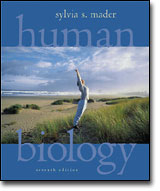|
 |  Human Biology, 7/e Dr. Sylvia S. Mader
Feature Summary| Part VII contains new chapters. "Human Evolution" traces human evolution
from the origin of cell(s) to the
evolution of modern humans. This unique chapter presents the principles of evolution,
while at the same
time reviewing human evolution. "Ecosystems and Human Interferences" presents
the principles of ecology
and shows how human activities disrupt biogeochemical cycles, leading to untoward
effects
including pollution. "Conservation of Biodiversity" explores the current
biodiversity crisis
and shows how the loss of so many species can be detrimental to
humankind.
Technology aids are organized according to the major sections on the e-Learning
Connection page
found at the end of each chapter. Students can easily determine the available
resources to help explain
difficult concepts. The same design is utilized for the Online Learning Center,
so that students can quickly
find an activity of interest. Other activities help students make full use of
the Bioethical Focus boxes and
Human Systems Work Together boxes.
Relevancy of the text is enhanced due to the inclusion of such topics as
sexually transmitted diseases,
eating disorders, allergies, pulmonary disorders, hepatitis infections, xenotransplantation,
modern
reproductive technologies, human cloning, the human genome project, and gene
therapy to treat cancer.
Health Focus and Ecology Focus readings support the two major
themes of the text; the study of
human anatomy and physiology and the role of humans in the biosphere. A new
Bioethical Focus box found
throughout the text introduces students to many of the bioethical questions
that face us every day.
Challenging questions are provided that can be used as a basis for class discussion.
The Online Learning
Center allows students to further explore these issues by taking a quiz, reading
articles, and writing an
essay explaining their point of view.
The vibrant art program adds vitality to illustrations and enhances the
appeal of the text. Micrographs
are integrated into illustrations and provide realism. Visual focus illustrations
give a pictorial overview of key
topics. Color coding is used both for biological molecules and for human tissues
and organs.
Homeostasis is again emphasized in this edition. An icon s calls attention
to those
portions of the text that discuss homeostasis. Each systems chapter has a major
section that discusses
how that system works with other systems of the body to achieve homeostasis.
This section is
supported by a Human Systems Work Together box, which also shows how that organ
system works
with the other systems making homeostasis possible.
|
|
|



 2002 McGraw-Hill Higher Education
2002 McGraw-Hill Higher Education

 2002 McGraw-Hill Higher Education
2002 McGraw-Hill Higher Education